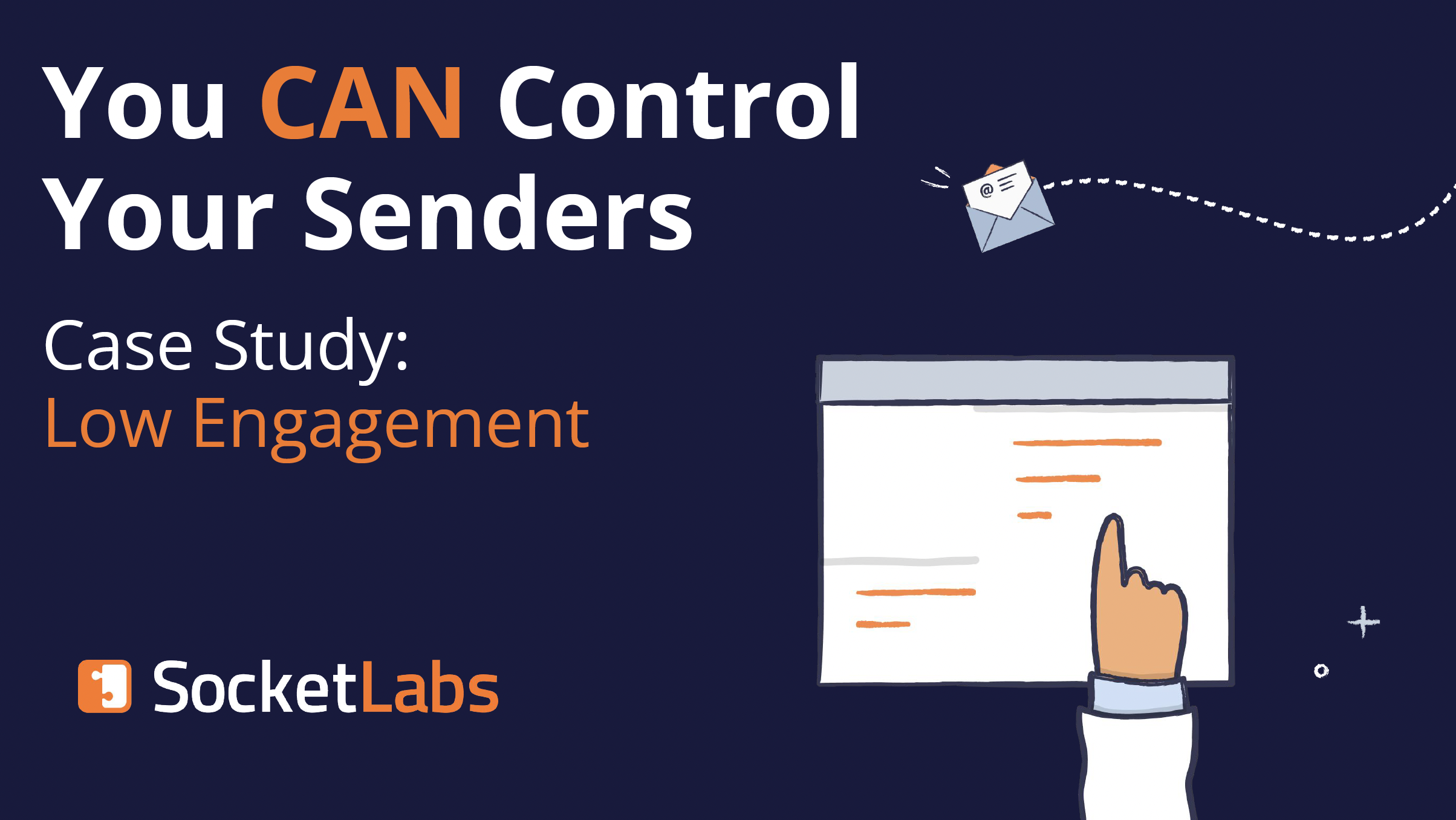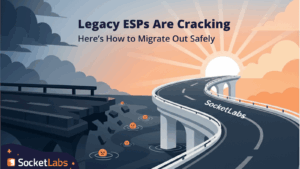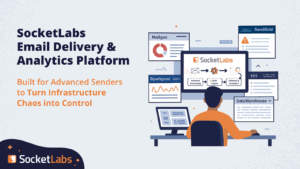Modern email operations demand more than just basic sending capabilities — they require intelligent routing, comprehensive visibility, and the flexibility to handle infinite complexity without custom development. SocketLabs was architected from the ground up to serve organizations that have outgrown traditional ESP limitations and need infrastructure that adapts to their unique requirements rather than forcing them into rigid constraints.
This is the deeper technical walkthrough of the platform — intended for infrastructure, product, and engineering teams evaluating how SocketLabs works under the hood.
Looking for a higher-level perspective on why architecture matters for advanced senders? Read our executive overview: The SocketLabs Email Infrastructure Platform: Built for Advanced Senders to Turn Infrastructure Chaos Into Control.
The SocketLabs Platform Philosophy
Separated Architecture for Complex Operations
The SocketLabs platform fundamentally differs from traditional ESPs through its separated architecture approach. Instead of monolithic pipelines that tightly couple input processing with output delivery, we’ve designed three distinct layers:
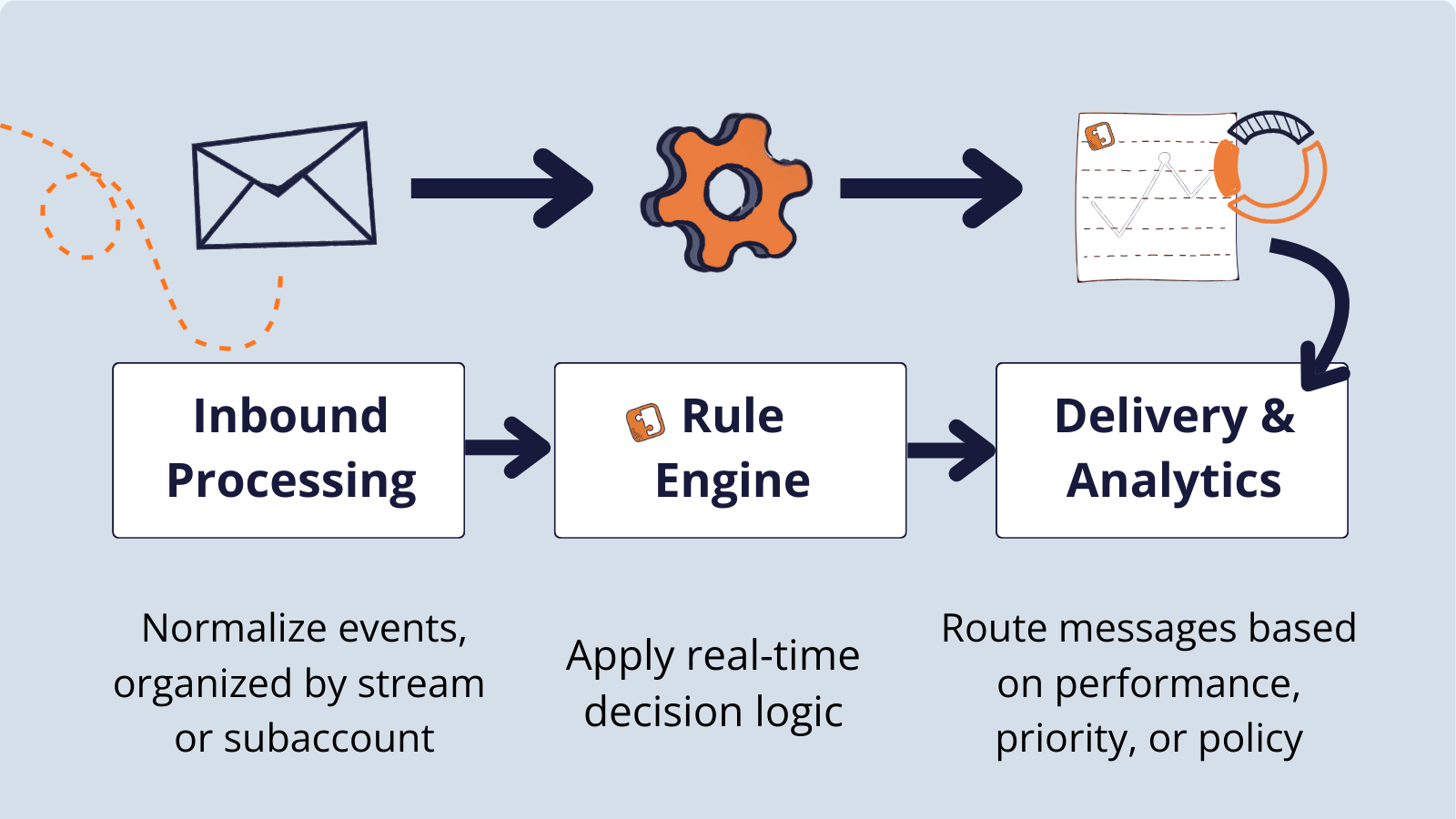
Inbound Processing → Intelligent Rule Engine → Outbound Delivery
This separation enables independent optimization of each layer and provides the flexibility to route any input through any output based on intelligent decision-making — something impossible with traditional ESP architectures.
At a high level, the SocketLabs platform is built on a separated architecture — inbound, intelligence, and outbound. But for teams who want to see the full picture, here’s how those layers actually come together in practice:
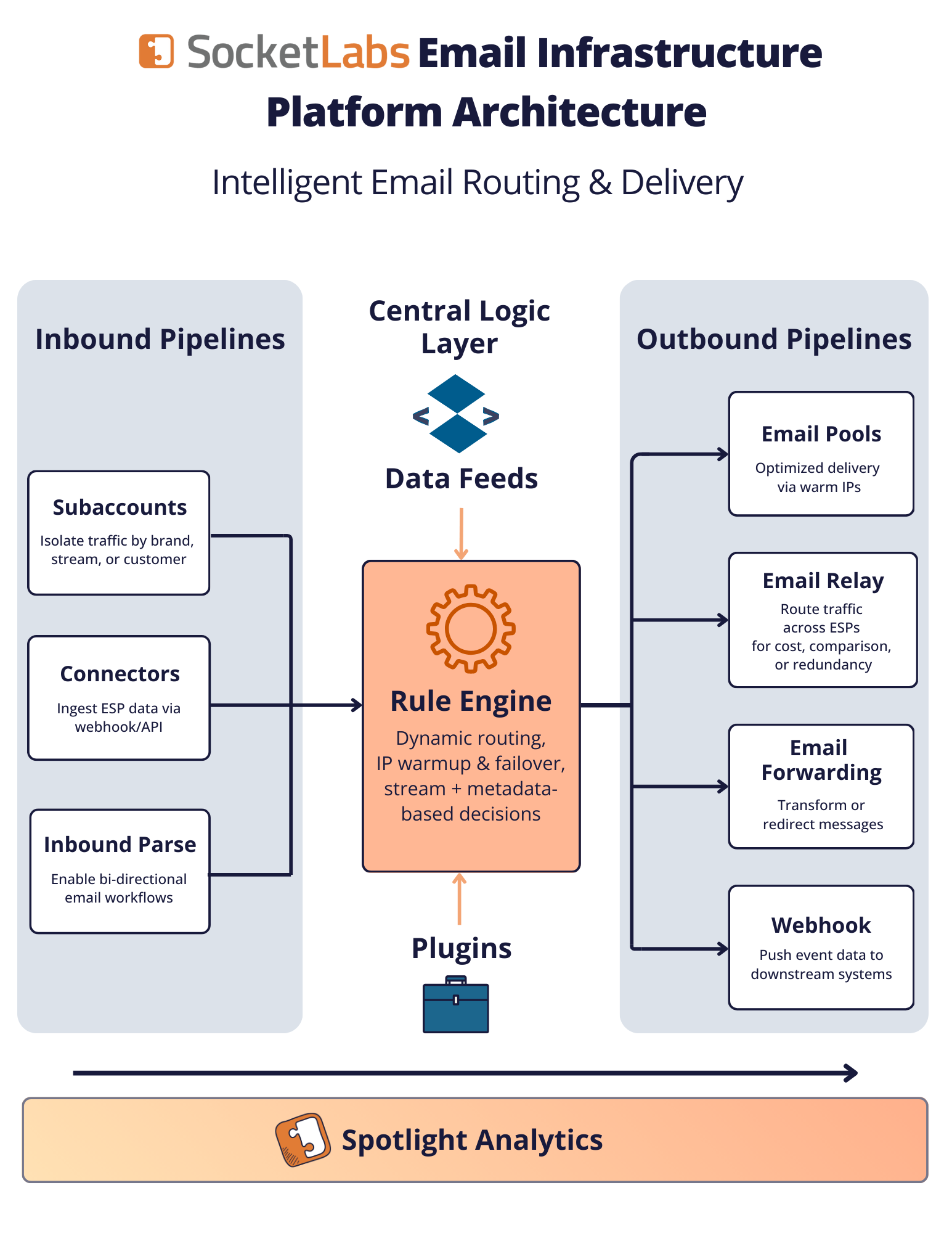
This architecture diagram shows how inbound pipelines feed into the central Rule Engine for intelligent decision-making, then route through flexible outbound pipelines — all with Spotlight Analytics providing real-time visibility across every layer.
We believe that email infrastructure should handle complexity through intelligent configuration, not custom code. Your infrastructure should adapt to your business logic, not constrain it.
The Problem with Traditional ESP Architecture
Legacy ESPs like SendGrid, Mailgun, and Amazon SES were built during an era when email operations were simpler and more predictable. Their monolithic architectures create fundamental limitations:
- Tight coupling: Changes to input processing affect the entire delivery chain
- Static routing: Basic rules that don’t adapt to real-time conditions
- Limited intelligence: No sophisticated decision-making capabilities
- Siloed analytics: Separate tools that don’t inform delivery decisions
- Code-heavy customization: Complex scenarios require extensive development
Most critically, these platforms force organizations to choose between simplicity and capability. You either accept basic functionality or invest heavily in custom development that becomes technical debt.
For a deeper dive into why legacy ESPs create risk, see our recent blog on email infrastructure chaos.
Core Components of the SocketLabs Architecture
1. Intelligent Rule Engine: The Strategic Brain
The Rule Engine operates as the decision-making core between inbound processing and outbound delivery, enabling sophisticated routing logic without requiring custom development.
Problems Solved:
- Dynamic routing based on real-time performance data
- Automated IP warmup and reputation management
- Complex multi-stream operations without custom code
- Intelligent failover and redundancy management
How It Works:
- Analyzes all inbound data and contextual information
- Applies business logic and performance optimization algorithms
- Makes real-time routing decisions based on current conditions
- Operates independently of input sources and output methods
Here’s what that looks like in practice — setting up routing rules in the SocketLabs Rule Engine:
Key Differentiator: While competitors require extensive coding for complex routing scenarios, our Rule Engine handles sophisticated logic through codeless configuration that adapts to changing requirements without development overhead.
Practical applications include separating VIP traffic from bulk, gradually warming IPs, or failing over to a backup ESP without code changes.
2. Unified Inbound Processing Layer
Our inbound architecture standardizes and enriches all email-related data before it reaches the intelligence layer.
Connectors:
- Real-time webhook data ingestion from multiple ESPs (SendGrid, Mailgun, SparkPost, Amazon SES)
- Automated data normalization across different ESP formats
- Event standardization and contextual enrichment
Subaccounts:
- Flexible entry points for different email streams, business units, or customers
- Independent authentication and configuration per subaccount
- Isolated reputation management and custom handling rules
Inbound Parse:
- Processing incoming email communications for bidirectional workflows
- Content extraction and automated routing capabilities
- Integration with business systems via webhooks
Practical applications include analyzing campaign health across multiple brands, supporting multi-tenant SaaS traffic, or parsing inbound messages for automated workflows.
3. Flexible Outbound Delivery Options
The outbound layer provides multiple delivery methods that can be used individually or in combination based on Rule Engine decisions.
Email Pools:
- Premium cloud-based sending with optimized IP reputation management
- Automated IP warming with intelligent traffic shaping
- 99.999% uptime reliability with advanced queue management
Email Relay:
- Intelligent routing through multiple ESP platforms
- Cost-based and performance-based routing decisions
- Zero-downtime migrations through gradual traffic shifting
Email Forwarding:
- Advanced message routing and transformation capabilities
- Conditional routing based on content or metadata
- Complex workflow enablement
Hurricane MTA:
- On-premise deployment for maximum control and compliance capabilities
- Windows Server-based MTA software
- Maximum control for compliance-sensitive industries and data sovereignty requirements
Practical applications include migrating between ESPs with zero downtime, routing across hybrid cloud/on-prem environments, or shaping traffic intelligently for performance and cost.
4. Integrated Analytics: Spotlight Platform
Unlike competitors who bolt analytics onto existing infrastructure, Spotlight is natively integrated with our delivery platform, enabling real-time optimization.
H4: Monitoring & Recommendations
StreamMonitor with Guided Insights:
- ML-powered anomaly detection across all email streams
- Proactive issue identification before problems impact delivery
- AI-driven actionable recommendations integrated directly within monitoring
- Predictive analytics forecasting potential delivery issues
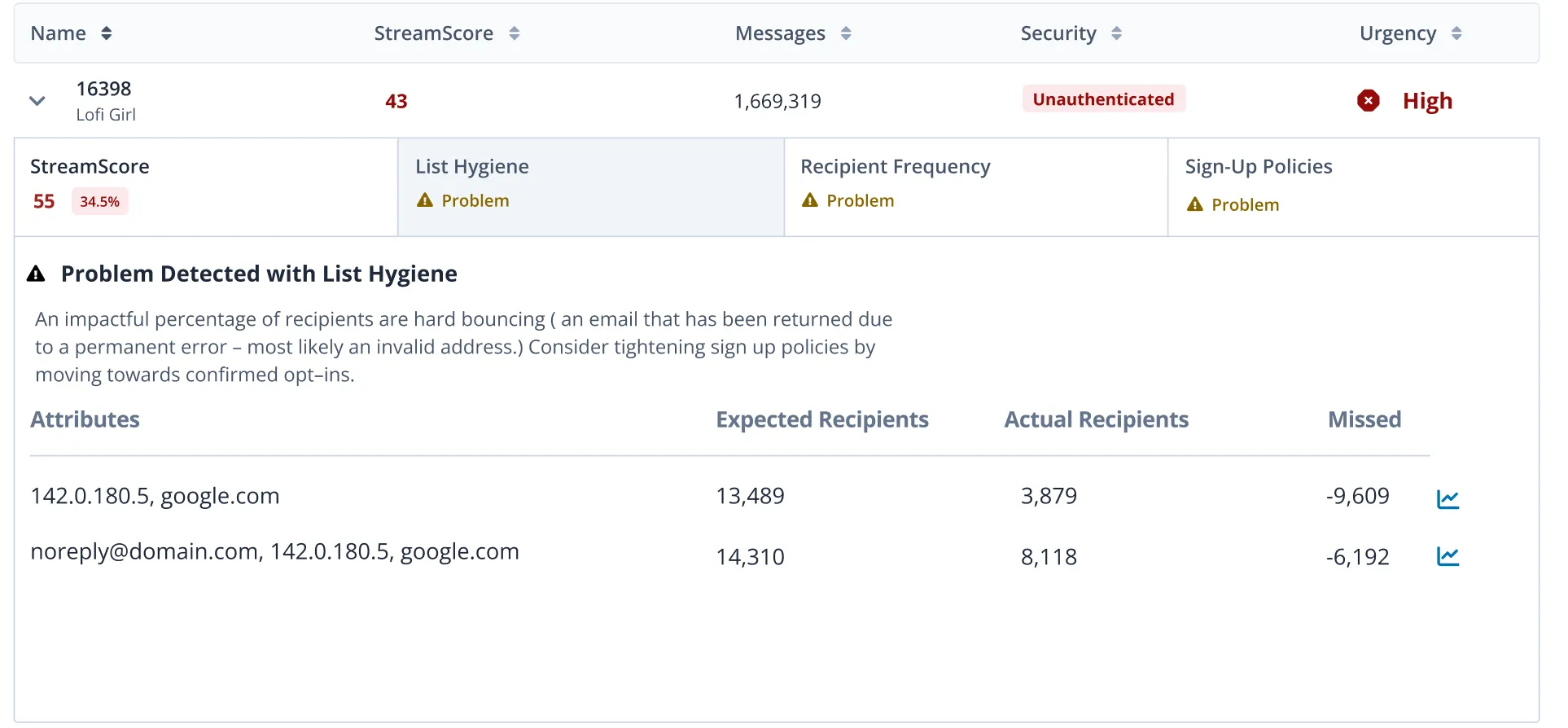
H4: Deep Reporting & Event Analysis
Advanced Multi-Dimensional Reporting:
- Advanced filtering capabilities for complex data analysis
- Dashboards with unlimited views
- Real-time performance monitoring across multiple ESPs
- Customizable views for different stakeholder needs
Detailed Event Analysis:
- Granular event-level logging for all email interactions (delivered, bounce, open, click, unsubscribe, spam complaint events)
- Advanced Splunk-like search and filtering for forensic analysis
- Export functionality for external analysis and compliance reporting
- Historical event data retention for trend analysis
StreamScore:
- Simple, color-coded performance scoring for quick health assessment
- Daily calculation based on rolling 15-day message history
- Component breakdown across Audience, Engagement, Reputation, and Security scores
Practical applications include comparing performance across ESPs side by side, diagnosing issues at the domain or stream level, or running forensic searches across all email events.
Here’s an example of Spotlight in action:
Built for Real-World Complexity
Seamless ESP Migration
Traditional migrations require running parallel systems, doubling costs and complexity. SocketLabs enables gradual migration through intelligent traffic splitting — monitoring performance across old and new ESPs while automatically optimizing routing based on real-time results.
Multi-Stream Management
Organizations managing different message types (transactional, marketing, notifications) across multiple customer bases need sophisticated reputation management. Our Rule Engine automatically handles this complexity, applying appropriate strategies for each stream without manual intervention.
Enterprise Scale Operations
Platforms serving thousands of customers need multi-tenant architecture with performance isolation and granular control. SocketLabs handles this as a core design principle, not an afterthought.
API-First, Configuration-Driven Approach
The entire SocketLabs platform offers complete API parity with UI functionality, enabling:
- Programmatic management of all platform capabilities
- Automated provisioning for multi-tenant scenarios
- Integration with existing business systems and workflows
- Codeless complexity management through intelligent configuration
Unlike platforms that reserve advanced features for UI-only access, every SocketLabs capability is available through both interfaces.
The Complete Email Operations Lifecycle
SocketLabs supports organizations through every phase of their email evolution:
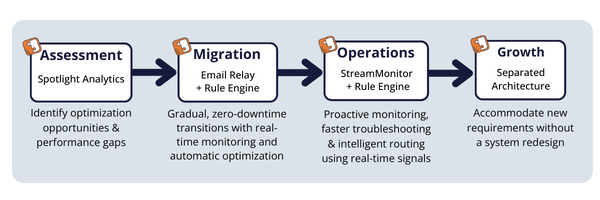
Assessment Phase: Spotlight provides unified visibility across existing ESP infrastructure, identifying optimization opportunities and performance gaps.
Migration Phase: Email Relay and Rule Engine enable gradual, zero-downtime transitions with real-time performance monitoring and automatic optimization.
Operations Phase: StreamMonitor and Guided Insights provide proactive monitoring and intelligent recommendations, while the Rule Engine continuously optimizes delivery based on real-time conditions.
Growth Phase: The separated architecture scales complexity naturally, accommodating new requirements without system redesign or extensive reconfiguration.
Why Architecture Matters
The fundamental difference between SocketLabs and traditional ESPs lies in our architectural approach to complexity. While competitors force organizations to choose between simplicity and capability, our separated architecture with intelligent rule-based processing enables sophisticated operations through configuration rather than code.
This architectural advantage translates into measurable business outcomes:
- 30-50% reduction in delivery issues through intelligent routing
- 65% less time spent troubleshooting email problems
- Zero downtime during ESP migrations
- 40% cost savings during transition periods
- 3.2x faster problem resolution
Looking Forward
SocketLabs’ separated architecture creates the foundation for the future of email infrastructure — where analytics inform delivery decisions in real-time, creating a perfect intelligence loop that continuously improves performance without human intervention.
The platform is designed to evolve with emerging technologies and changing business requirements, ensuring that organizations choosing SocketLabs today have the architectural foundation needed for tomorrow’s email operations.
For organizations managing complex email operations that have outgrown traditional ESP limitations, SocketLabs provides the architectural foundation needed to scale sophistication without scaling complexity. Talk with our team about how SocketLabs can transform your email infrastructure — from architectural design to implementation strategy.

